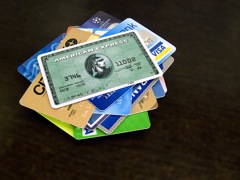 Tony will finish graduate school in May 2010, but after that he’ll have a semester of student teaching before he’s certified to teach. Right now he receives a stipend for teaching undergraduate classes, which he won’t receive while student teaching. Unfortunately, this means we’ll have to live on my income alone for about 7 months. The student teaching program is full time, and we’re hoping he’ll be able to work nights and weekends, but I don’t want to count on that considering the trouble he’s had searching for part time jobs in the past.
Tony will finish graduate school in May 2010, but after that he’ll have a semester of student teaching before he’s certified to teach. Right now he receives a stipend for teaching undergraduate classes, which he won’t receive while student teaching. Unfortunately, this means we’ll have to live on my income alone for about 7 months. The student teaching program is full time, and we’re hoping he’ll be able to work nights and weekends, but I don’t want to count on that considering the trouble he’s had searching for part time jobs in the past.
We’re also preparing ourselves for after the move. I’ve done a little research, and in the area where we’re moving, it looks like we can expect Tony to start somewhere between $32,000 and $35,000 as a high school teacher (according to what I read, he’ll be paid slightly more than a normal first year teacher because of his master’s degree and experience). Of course, this number is just an estimate. If you have any information about what starting teachers in the Indianapolis metro area make, by all means please pass it along!
I will continue to generate freelance income, but I won’t be working full time since we’re planning to start a family shortly after Tony finds a teaching job. Freelancing is feast or famine, so we don’t want to factor my income into our normal budget. That means we need to start planning now for a reduced income with a baby.
On top of all this, our savings goal has increased since we’d like to buy a house sooner rather than later.
To help us reach these goals, we’ve decided to reduce our monthly spending by about 5% and increase our total monthly savings amount by 25%. Put simply, that means we’re cutting about $150 from our monthly spending and adding it to our monthly savings.
I spent some time pouring over the budget. I determined that if we continue living on a cash budget, cut our weekly spending by $25 a week and make some minor adjustments in other areas, this is totally doable. If we hadn’t spent the summer on such a tight budget, I never would have thought this was possible. I thought we were saving as much as we possibly could, but after a summer of tight expenses, instead of feeling like we need more, I only see where we can cut.
In real terms, this means we’re cutting our grocery budget from $50-$60 a week to $40-$50. Our “shopping” budget, which covers household expenses like cleaning products and other miscellaneous items, is being cut from $20 per week to $15.
As we move into fall, we’ll increase our additional savings by another $50 when our electric bill drops from $100+ during the summer to $40-$60 a month during the cool winter months.
Over the next 8 months, this will increase our total savings by about $1500. More importantly, it will better prepare us for next summer and fall when we lose 1/3 of our total income. It will also make it easier for us to transition into a single income home in spring 2011 when I’m no longer working full time.
My point is this: if you’re looking ahead to a lower income, now is the time to make cuts. It’s always easier to transition slowly than it is to jump into the cold water. Don’t wait until you lose your income. Learn to live on less now so you can bank the extra money for the future.

 I personally use Netflix, but this deal is almost too good to pass up. Today first-time users can enroll in a
I personally use Netflix, but this deal is almost too good to pass up. Today first-time users can enroll in a  Last weekend, I made a huge purchase. I bought a camera that cost almost a whole paycheck. Yikes.
Last weekend, I made a huge purchase. I bought a camera that cost almost a whole paycheck. Yikes.

